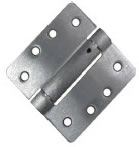
Do you know the difference between a butt hinge and a spring hinge? They are two of the most common types of door hinges. Most doors are connected to the adjacent frame with a set of butt or spring hinges. While they are used in many of the same applications, however, butt and spring hinges aren’t the same.
What Is a Butt Hinge?
A butt hinge is a type of mechanical bearing that features two leafs of equal size and a pin-secured knuckle. The rectangular plates are the leafs. When pressed together, the leafs will form a hollow knuckle in the center. A pin is placed through this knuckle to hold the two leafs together.
Butt hinges are used to join two objects while simultaneously allowing for a limited degree of rotation between the objects. When used on a door, you can swing the door open and away from the adjacent frame. Butt hinges are designed specifically to sit in a shallow groove, which is why they are also known as “mortise hinges.”
What Is a Spring Hinge?
A spring hinge is a type of mechanical bearing that features two leafs and one or more springs. Most spring hinges look like butt hinges, and as previously mentioned, they are commonly used on doors. Spring hinges, though, contain one or more springs.
Springs, of course, are devices that store mechanical energy. There are extension springs that become longer under a tension load, and there are compression springs that become shorter under a tension load. Most spring hinges contain the former type of spring.
Differences Between Butt and Spring Hinges
Only spring hinges contain a spring. The spring is typically found in the center. In comparison, butt hinges feature a pin-secured knuckle in the center.
What’s the purpose of this spring exactly? The spring is designed to automatically close the door with which it’s used. With a traditional butt hinge, you’ll have to manually push the door closed after opening it. With a spring hinge, the mechanical energy of the spring will automatically close the door. Opening the door will extend the spring, thereby creating mechanical energy. This mechanical energy will then pull the door shut so that you don’t have to.
With their ability to close automatically, spring hinges are more common in commercial applications. Many commercial facilities, for instance, use spring hinges on their doors so that workers can walk in and out without worrying about closing the doors behind them.
